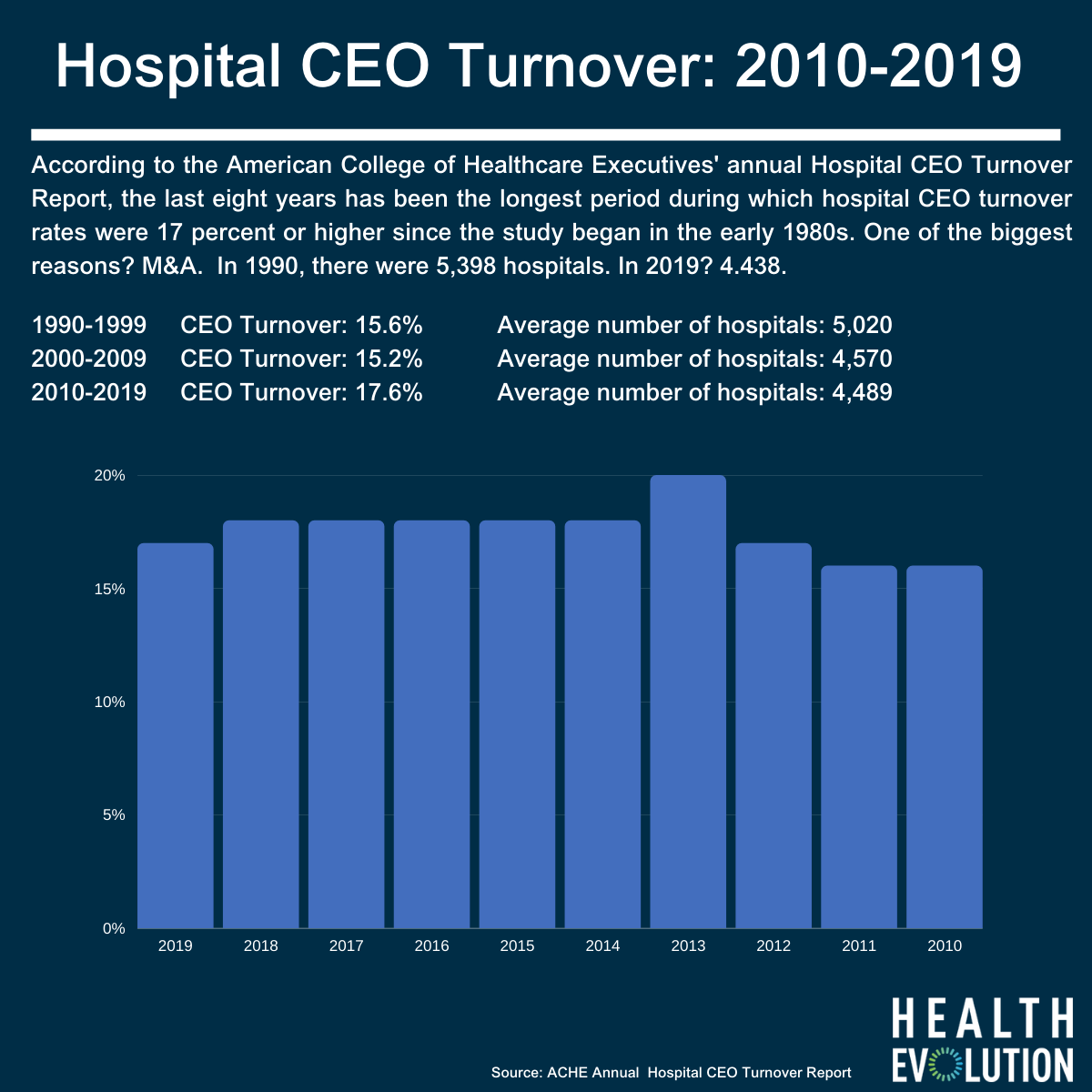Nearly one-in-five CEOs stepped down for various reasons in 2019, according to a report from the American College of Healthcare Executives (ACHE).
In 2019, hospital CEO positions turned over at a rate of 17 percent. This is a small decrease from 18 percent in 2018, but the past eight years has been the longest period during which hospital CEO turnover rates were 17 percent or higher since the study began in the early 1980s.
“If you look over the last six or seven years, you’re seeing more mergers and acquisitions. I think the market is changing. When we look at the number of hospitals in 2010 and you look at the number of hospitals in 2020, you would have less. There’s something to that trend,” says Deborah Bowen, ACHE’s president and CEO.
“I think people are also really looking strategically at their administrative structures and management teams. I really think they’re trying to understand how to get more standardization in systems. Certainly, with COVID, I think we saw the benefits of people having more standardized, centralized protocols that they could export to all of their facilities. I think these big systems are looking at their leadership structures to make sure they’re serving patients in a quality way and the way in which patients obviously expect to be treated.”
The ACHE report found that Delaware had the highest rate of hospital CEO turnover with 40 percent and South Dakota had the lowest turnover at 2 percent. Bowen says the report focuses on nonfederal, general and surgical hospitals.
The trends in hospital CEO turnover mesh with the overall CEO turnover trends reported by Challenger, Gray, & Christmas. The Chicago-based outplacement firm found that there were 1,640 departures by the heads of U.S. businesses in 2019, which is a “staggering number” and the highest they’ve had on record. Hospitals are among the highest sectors of CEO turnover reported by Challenger, Gray, & Christmas.
Health Evolution spoke with Bowen about the ACHE’s turnover report, the potential impact from COVID-19 on CEO turnover and what CEOs should know about the near future.
Health Evolution: What were the major findings of this report?
Bowen: We do this report annually and have done it for quite some time. As you can tell from the data, the 2019 turnover rate was 17 percent, which is slightly different but not significantly different than previous years. It’s following the trends we’re seeing over the last 6-7 years where turnover has been higher. People can leave for a lot of reasons. The way this is evaluated, we take the CEOs who were in a position Jan. 1 and compare if they are in the same role the following year. So, people can be promoted. They can retire. They can move around within a health system. They can separate from the organization for whatever reason. There are a lot of different reasons why people are not in that CEO role one year later.
Health Evolution: How will COVID impact turnover rates, it at all?
Bowen: If only I had a crystal ball. I’m sure you’ve seen AHA data that says the industry will be hit hard, somewhere in the neighborhood of $323 billion in projected losses. That being said, I think there are competing trends and it’s difficult to assess where they’re going to land. A lot of rural hospitals are closing. What does that mean? Are we going to end up with more micro-satellite facilities in those areas, which may not technically count as hospitals?
At the same time, you’re seeing in times of crisis, it’s probably not a great time to change your leadership. We’ve seen evidence that strong leadership can make a difference to patient care and how quickly organizations are able to respond to the needs of the community and partner with others to get things done. Will CEOs approaching retirement choose to opt out earlier? I don’t know. We haven’t seen that yet, but it could happen.
Health Evolution: CEO turnover is something that may be out of a CEO’s hands – what can they do to prevent becoming a statistic on this report?
Bowen: There is nothing that substitutes for a good plan. Most CEOs are cognizant that they need to be developing their leadership talent across the organization. Succession planning is an important dimension of the work of leaders. You want the organization to sustain itself and live beyond you in service into the community. Also, you need to be transparent and you need to be proactive in your discussions. That’s a growing trend in health care. People need to take seriously how they cultivate leaders in their organization because a strong leadership team can make a big difference in how we advance health for everybody.
Health Evolution: What’s the message to send to health care CEOs reading this report?
Bowen: CEOs historically have been great stewards of providing health in the community. Leadership does make a difference. If I were paying attention to turnover, I’d want my own plan for sustaining the organization over time. There’s nothing that substitutes for good planning and execution. At the end of the day, this is a people business. We pride ourselves on our relationships with our workforce and the people we serve.










